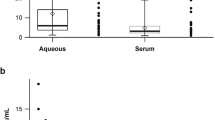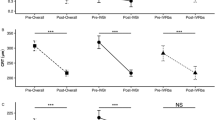Abstract
Background
To evaluate the baseline spectral-domain optical coherence tomography (SD-OCT) characteristics of macular edema (ME) due to branch retinal vein occlusion (BRVO) for visual outcome after intravitreal bevacizumab injection.
Methods
Fifty-nine patients treated in one eye with intravitreal bevacizumab for ME due to BRVO were retrospectively reviewed. Stepwise multiple regression analysis was used to evaluate the relative contribution of several variables, including SD-OCT characteristics such as photoreceptor inner segment/outer segment (IS/OS) integrity and external limiting membrane (ELM status), baseline best-corrected visual acuity (BCVA), and baseline central retinal thickness (CRT) with final visual outcome.
Results
Thirty-one patients (52.5 %) had disrupted photoreceptor IS/OS integrity. The mean BCVA improved significantly from 0.50 logMAR (20/63 Snellen equivalent) to 0.10 logMAR (20/25 Snellen equivalent) in the intact photoreceptor group (p = 0.000, paired t-test). However, the mean BCVA was improved in the disrupted photoreceptor group, from 1.10 logMAR (20/252 Snellen equivalent) to 0.94 logMAR (20/174 Snellen equivalent), which was not statistically significant (p = 0.177, paired t-test). ELM was disrupted in 23 patients (39.0 %). The mean BCVA improved significantly from 0.63 logMAR (20/85 Snellen equivalent) to 0.26 logMAR (20/36 Snellen equivalent) in the intact ELM group (p = 0.000, paired t-test), however, not significantly improved in the disrupted ELM group, from 1.09 logMAR (20/246 Snellen equivalent) to 1.01 logMAR (20/205 Snellen equivalent) (p = 0.563, paired t-test). The strongest individual predictor of final BCVA among patients with ME due to BRVO was the integrity of photoreceptor IS/OS layer on SD OCT (r 2 = 0.514, p = 0.000, stepwise multiple regression), but the most efficient model was the combination of the photoreceptor IS/OS integrity, ELM status, and baseline BCVA (r 2 = 0.671, p = 0.000, stepwise multiple regression). The strongest predictor of final BCVA was the status of photoreceptor IS/OS integrity (β = 0.532, p = 0.000, stepwise multiple regression), followed by ELM status (β = 0.325, p = 0.006, stepwise multiple regression), and the baseline BCVA (β = 0.238, p = 0.013, stepwise multiple regression).
Conclusion
Our results suggest that baseline SD-OCT characteristics, the status of photoreceptor IS/OS and ELM can be helpful in predicting the final visual outcome after intravitreal bevacizumab injection in these patients.



Similar content being viewed by others
References
Greer DV, Constable IJ, Cooper RL (1980) Macular oedema and retinal branch vein occlusion. Aust J Ophthalmol 8:207–209
Rehak J, Rehak M (2008) Branch retinal vein occlusion: pathogenesis, visual prognosis, and treatment modalities. Curr Eye Res 33:111–131
Klein R, Klein BE, Moss SE, Meuer SM (2000) The epidemiology of retinal vein occlusion; the Beaver Dam Eye Study. Trans Am Ophthalmol Soc 98:133–141
Costa RA, Jorge R, Calucci D, Melo LA Jr, Cardillo JA, Scott IU (2007) Intravitreal bevacizumab (Avastin) for central and hemiretinal vein occlusions: IBeVO study. Retina 27:141–149
Pai SA, Shetty R, Vijayan PB, Venkatasubramaniam G, Yadav NK, Shetty BK, Babu RB, Narayana KM (2007) Clinical, anatomic, and electrophysiologic evaluation following intravitreal bevacizumab for macular edema in retinal vein occlusion. Am J Ophthalmol 143:601–606
Kondo M, Kondo N, Ito Y, Kachi S, Kikuchi M, Yasuma TR, Ota I, Kensaku M, Terasaki H (2009) Intravitreal injection of bevacizumab for macular edema secondary to branch retinal vein occlusion: results after 12 months and multiple regression analysis. Retina 29:1242–1248
Badala F (2008) The treatment of branch retinal vein occlusion with bevacizumab. Curr Opin Ophthalmol 19:234–238
Prager F, Michels S, Kriechbaum K, Georgopoulos M, Funk M, Geitzenauer W, Polak K, Schmidt-Erfurth U (2009) Intravitreal bevacizumab (Avastin) for macular oedema secondary to retinal vein occlusion: 12-month results of a prospective clinical trial. Br J Ophthalmol 93:452–456
Hoeh AE, Ruppenstine M, Ach T, Ach T, Dithmar S (2010) OCT patterns of macular edema and response to bevacizumab therapy in retinal vein occlusion. Graefes Arch Clin Exp Ophthalmol 248:1567–1572
Holladay JT (1997) Proper method for calculating average visual acuity. J Refract Surg 13:388–391
Hoh AE, Schaal KB, Dithmar S (2007) Central and branch retinal vein occlusion. Current strategies for treatment in Germany, Austria, and Switzerland. Ophthalmologe 104:290–294
The Branch Vein Occlusion Study Group (1984) Argon laser photocoagulation for macular edema in branch vein occlusion. Am J Ophthalmol 98:271–282
Jonas JB, Akkoyun I, Kamppeer B, Kreissiq I, Degenring RF (1995) Branch retinal vein occlusion treated by intravitreal triamcinolone acetonide. Eye 19:65–71
Avitabile T, Longo A, Reibaldi A (2005) Intravitreal triamcinolone compared with macular laser grid photocoagulation for the treatment of cystoid macular edema. Am J Ophthalmol 140:695–702
Hoeh AE, Ach T, Schaal KB, Scheuerle AF, Dithmar S (2009) Long-term follow-up of OCT-guided bevacizumab treatment of macular edema due to retinal vein occlusion. Graefes Arch Clin Exp Ophthalmol 247:1635–1641
Chung EJ, Hong YT, Lee SC, Kwon OW, Koh HJ (2008) Prognostic factors for visual outcome after intravitreal bevacizumab for macular edema due to branch retinal vein occlusion. Graefes Arch Clin Exp Ophthalmol 246:1241–1247
Ach T, Hoeh AE, Schaal KB, Scheuerle AF, Dithmar S (2010) Predictive factors in macular edema in intravitreal bevacizumab therapy of retinal vein occlusion. Graefes Arch Clin Exp Ophthalmol 248:155–159
Ota M, Tsujikawa A, Murakami T, Yamaike N, Sakamoto A, Kotera Y, Miyamoto K, Kita M, Yoshimura N (2008) Foveal photoreceptor layer in eyes with persistent cystoid macular edema associated with branch retinal vein occlusion. Am J Ophthalmol 145:273–280
Kriechbaum K, Michels S, Prager F, Georgopoulos M, Funk M, Geitzenauer W, Schmidt-Erfurth U (2008) Intravitreal Avastin for macular oedema secondary to retinal vein occlusion: a prospective study. Br J Ophthalmol 92:518–522
Spaide RF, Lee JK, Klancnik JM, Gross NE (2003) Optical coherence tomography of branch retinal vein occlusion. Retina 23:343–347
Yamaike N, Tsujikawa A, Ota M, Sakamoto A, Kotera Y, Kita M, Miyamoto K, Yoshimura N, Hangai M (2008) Three-dimensional imaging of cystoid macular edema in retinal vein occlusion. Ophthalmology 115:355–362
Murakami T, Tsujikawa A, Ohta M, Miyamoto K, Kita M, Watanabe D, Takagi H, Yoshimura N (2007) Photoreceptor status after resolved macular edema in branch retinal vein occlusion treated with tissue plasminogen activator. Am J Ophthalmol 143:171–173
Eandi CM, Chung JE, Cardillo-Piccolino F, Spaide RF (2005) Optical coherence tomography in unilateral resolved central serous chorioretinopathy. Retina 25:417–421
Piccolino FC, de la Longrais RR, Ravera G, Eandi CM, Ventre L, Abdollahi A, Manea M (2005) The foveal photoreceptor layer and visual acuity loss in central serous chorioretinopathy. Am J Ophthalmol 139:87–99
Sandberg MA, Brockhurst RJ, Gaudio AR, Berson EL (2005) The association between visual acuity and central retinal thickness in retinitis pigmentosa. Invest Ophthalmol Vis Sci 46:3349–3354
Maheshwary AS, Oster SF, Yuson RM, Cheng L, Mojana F, Freeman WR (2010) The association between percent disruption of the photoreceptor inner segment–outer segment junction and visual acuity in diabetic macular edema. Am J Ophthalmol 150:63–67
Shin HJ, Chung H, Kim HC (2011) Association between integrity of foveal photoreceptor layer and visual outcome in retinal vein occlusion. Acta Ophthalmol 89:35–40
Bolz M, Schmidt-Erfurth U, Deak G, Mylonas G, Kriechbaum K, Scholda C, Diabetic Retinopathy Research Group Vienna (2009) Optical coherence tomographic hyperreflective foci: a morphologic sign of lipid extravasation in diabetic macular edema. Ophthalmology 116:914–920
Ota M, Nishijima K, Sakamoto A, Murakami T, Takayama K, Horii T, Yoshimura N (2010) Optical coherence tomographic evaluation of foveal hard exudates in patients with diabetic maculopathy accompanying macular detachment. Ophthalmology 117:1996–2002
Wolf-Schnurrbusch UE, Ghanem R, Rothenbuehler SP, Enzmann V, Framme C, Wolf S (2011) Predictors of short-term visual outcome after anti-VEGF therapy of macular edema due to central retinal vein occlusion. Invest Ophthalmol Vis Sci 52:3334–3337
Ota M, Tsujikawa A, Murakami T, Kita M, Miyamoto K, Sakamoto A, Yamaike N, Yoshimura N (2007) Association between integrity of foveal photoreceptor layer and visual acuity in branch retinal vein occlusion. Br J Ophthalmol 91:1644–1649
Acknowledgment/disclosure
The authors indicate no financial support or financial conflict of interest. Involved in design and conduct of study (HM Kang, EJ Chung, YM Kim, HJ Koh); collection of data (HM Kang, EJ Chung); management, analysis, and interpretation of data (HM Kang, EJ Chung, HJ Koh); and approval of the manuscript (HM Kang, EJ Chung, YM Kim, HJ Koh). This study followed the tenets of the Declaration of Helsinki. The Institutional Review Board at Severance Hospital approved optical coherence observation for eyes with macular and retinal disorders, the observational study for macular edema due to branch retinal vein occlusion at the treatment and follow-up, and the retrospective comparative analysis performed in this study.
Author information
Authors and Affiliations
Corresponding author
Additional information
Presented in part as a poster at the annual meeting of the Association for Research in Vision and Ophthalmology, Fort Lauderdale, Florida, May 2011.
The authors indicate no financial support or financial conflict of interest.
Rights and permissions
About this article
Cite this article
Kang, H.M., Chung, E.J., Kim, Y.M. et al. Spectral-domain optical coherence tomography (SD-OCT) patterns and response to intravitreal bevacizumab therapy in macular edema associated with branch retinal vein occlusion. Graefes Arch Clin Exp Ophthalmol 251, 501–508 (2013). https://doi.org/10.1007/s00417-012-2067-8
Received:
Revised:
Accepted:
Published:
Issue Date:
DOI: https://doi.org/10.1007/s00417-012-2067-8




